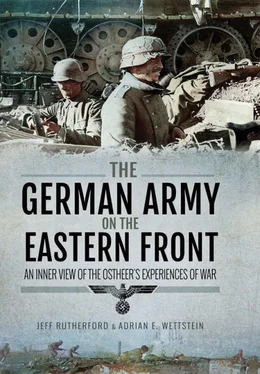During the previous deployment, the following deficiencies occurred in the ammunition supply:
A) Ammunition for light field howitzers
In the time from 29.8.-5.10.42, too many shells with combination fuses were supplied, sometimes more often than shells with an impact fuse. The regiment was therefore forced to fire combination fuse [shells] as impact fuse [shells]. Therefore a remarkable number of duds were observed. Ricochet fire is not possible with combination fuse [shells], since the fuses have no delay. In addition, combination fuses are more versatile in their design, making the production more difficult and expensive.
In the period from 14.10.-21.10.42, hollow charge [shells] had to be fired due to the lack of impact fuse [shells]. Ricochet fire is also not possible with these shells. The splinter effect of these shells is somewhat larger in impact up to 20m wider to the sides than in the normal shell, since the hollow charge has thinner walls. After 20m, it remains considerably less effective than the normal shell. The cause is the directional detonation wave acting in the direction of the longitudinal axis. This shell is more difficult and expensive to produce.
B) Ammunition for 10cm cannon 18
Sometimes gaps occur in the supply of special cartridge bags. The combating of enemy batteries, which were far in the rear area, could not take place. On 20.10., 10cm shells 19 FES [8]were delivered for the first time without notice. These shells could not be fired at first because the necessary ballistic tables were missing. After a telephone conversation with all available commands, the regiment learned that a regular ballistic table, the only one in the army area, was available from the I./Artillery Regiment 430. After copying the changed values from this ballistic table, shells FES could be fired.
C) Ammunition for heavy field howitzer 18
There is also a shortage of special cartridge bags for the heavy field howitzers’ ammunition. The range is thus limited to 9,775m. Batteries positioned at some distance cannot be combated, but [they] interfere with our own intentions unopposed. 15cm Grenade 19 with the designation o.M . [9]may be fired only up to the 5th charge (barrel bursts). The range is thus limited to 8,500m. Since the heavy field howitzer combats mostly [enemy] artillery at a great distance, such shells are useless. It would be better to completely pull them out of supply as they are only a burden.
On 2.9.42, 15cm Grenade 36 were delivered. Nothing was known about the firing of that shell from the heavy field howitzer. Higher commands were also unable to provide information. The shells were locked. At last on the 10.10.42, the regiment learned the set values for their firing. Due to the lack of impact fuse [shells], the heavy field howitzers also had to periodically fire shells with a combination fuse as an impact fuse [shells].
D) Ammunition for 12.2 cm Russian howitzers
As replacements for heavy field howitzers lost in the middle of September, 3 Russian 12.2cm calibre guns were deployed. These have a range up to 12,800m. The initially available 300 rounds were fired with good success. Further ammunition has not been found or supplied as yet. For 4 weeks, these guns have been without ammunition, hence worthless and only a burden. If the supply of 12.2cm ammunition remains hopeless, the regiment will be forced to give up the guns again.
E) Ammunition for 7.62cm guns
There are 3 7.62cm guns in the regiment. So far, all found captured munitions was fired. For a short period, the ammunition was supplied regularly. […]
F) New introduction
Notice about the introduction of new ammunition partly did not come to the regiment at all, partly belatedly and stingily. The persons responsible are thus not in a position to provide detailed information on the newly introduced ammunition. It would be desirable if the introductory decrees with detailed descriptions would also be distributed to the regiments.
This report clearly shows the problems of the broad array of guns and shells in use, as well as the logistic difficulties that arose as a result. The document also addressed the information flow issue, which was an essential part of the logistic system. This included not only the timely forwarding of information on new types of shells, such as use, effect, and ballistic tables, but also the flow of information on the use of ammunition from frontline staffs through higher command staffs to the groups and central institutions in the Reich that regulated the production of munitions and the loading of supply trains for the Eastern Front. This was a very demanding and elaborate – and still under-researched – administrative process that produced a massive flood of papers that have subsequently become valuable sources for military historians.
All the shells that could not be used due to either missing information or ballistic tables were a waste of transport capacity and this was even more the case at the end of a 2,000-kilometre supply line, hampered by many bottlenecks and frictions, as was the case for the Sixth Army in the battle for Stalingrad. Even though this Army was the point of the main effort from September 1942 on, ammunition remained scarce. Already after only a single week of fighting inside the city, munitions became a major concern for the Germans, as a report of the OKH Forward Officer attached to Sixth Army shows: [10]
Due to the especially heavy fighting inside Stalingrad, the troops suffer from an ammunition shortage. The 2nd Heavy Rocket Launcher Regiment that is especially useful for combat in an urban area has not been deployed due to a lack of munitions at LIst Corps, a situation that has existed for days. The supply of small quantities of munitions is not expected for 6-12 days.
Similarly a whole 10cm canon battalion (II./64) had to be withdrawn by LIst Corps due to lack of munitions. There is also no further ammunition available for the other thirteen 10cm cannon batteries of the army. [11]The entire army will have 400 rounds available again in another six days. [12]Improvement is not to be expected for three weeks.
Light and especially heavy field howitzer ammunition is continuously scarce due to its very high consumption inside the city and on the northern front.
Assault gun ammunition (long barrelled gun) is also scarce. At the moment this shortage is especially noticeable, since around 50% of the assault guns are long barrelled. Their use is therefore considerably limited.
Due to the mentioned lack of ammunition, key combat systems for urban warfare such as assault guns and rocket launchers (in German: Nebelwefer ) could not be deployed. The lack of artillery shells for the 10cm cannon 18 meant that the main artillery gun for counter-battery fire was not available, while the general lack of artillery shells impeded German defences north of Stalingrad. Combined with shortages of fuel and rations from September 1942 on, Sixth Army units were logistically not in a position to assault a city. These material problems were exacerbated by the German numerical manpower inferiority against a massively reinforced Soviet 62nd Army. Despite facing such obstacles, German troops were able to take nine tenths of the city, a credit to their superior tactics and low level command. [13]
Long and intensive combat frequently exhausted German ammunition stocks in a rapid manner, since the supply system could not cope with the German war machine’s voracious ammunition consumption. The situation was somewhat different when possibilities existed to build up stocks, such as was the case with the last major German offensive in summer 1943, Operation Citadel. The Germans took advantage of a lull in the fighting to concentrate fighting power – both men and material – for nearly three months before the operation opened. This allowed the army to fire an enormous mass of ammunition, as already described in the introduction to this chapter. But such a build-up and subsequent consumption, especially in the second half of the war, when the German Reich was also under pressure from Western Allied forces on the ground and in the skies, could only be achieved by strict conservation measures in all secondary theatres, including large sectors of the Eastern Front itself such as Army Group North’s area or the northern part of Army Group Centre, an often completely forgotten section of the line. The following order from the 87th Infantry Division, deployed in the Velizh area, gives an idea of such measures designed to save ammunition: [14]
Читать дальше






![John Stieber - Against the Odds - Survival on the Russian Front 1944-1945 [2nd Edition]](/books/405234/john-stieber-against-the-odds-survival-on-the-russian-front-1944-1945-2nd-edition-thumb.webp)





